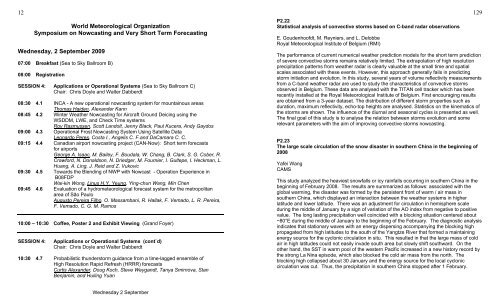World Meteorological Organization Symposium on Nowcasting - WMO
World Meteorological Organization Symposium on Nowcasting - WMO
World Meteorological Organization Symposium on Nowcasting - WMO
Create successful ePaper yourself
Turn your PDF publications into a flip-book with our unique Google optimized e-Paper software.
12<br />
P2.22<br />
<str<strong>on</strong>g>World</str<strong>on</strong>g> <str<strong>on</strong>g>Meteorological</str<strong>on</strong>g> <str<strong>on</strong>g>Organizati<strong>on</strong></str<strong>on</strong>g> Statistical analysis of c<strong>on</strong>vective storms based <strong>on</strong> C-band radar observati<strong>on</strong>s<br />
<str<strong>on</strong>g>Symposium</str<strong>on</strong>g> <strong>on</strong> <strong>Nowcasting</strong> and Very Short Term Forecasting<br />
E. Goudenhoofdt, M. Reyniers, and L. Delobbe<br />
Royal <str<strong>on</strong>g>Meteorological</str<strong>on</strong>g> Institute of Belgium (RMI)<br />
Wednesday, 2 September 2009<br />
The performance of current numerical weather predicti<strong>on</strong> models for the short term predicti<strong>on</strong><br />
07:00 Breakfast (Sea to Sky Ballroom B)<br />
08:00 Registrati<strong>on</strong><br />
SESSION 4: Applicati<strong>on</strong>s or Operati<strong>on</strong>al Systems (Sea to Sky Ballroom C)<br />
Chair: Chris Doyle and Walter Dabberdt<br />
08:30 4.1 INCA - A new operati<strong>on</strong>al nowcasting system for mountainous areas<br />
Thomas Haiden, Alexander Kann<br />
08:45 4.2 Winter Weather <strong>Nowcasting</strong> for Aircraft Ground Deicing using the<br />
WSDDM, LWE, and Check Time systems<br />
Roy Rasmussen, Scott Landolt, Jenny Black, Paul Kucera, Andy Gaydos<br />
09:00 4.3 Operati<strong>on</strong>al Frost <strong>Nowcasting</strong> System Using Satellite Data<br />
Le<strong>on</strong>ardo Peres, Costa I., Angelis C. F.and DaCamara C. C.<br />
09:15 4.4 Canadian airport nowcasting project (CAN-Now): Short term forecasts<br />
09:30 4.5<br />
for airports<br />
George A. Isaac, M. Bailey, F. Boudala, W. Chang, B. Clark, S. G. Cober, R.<br />
Crawford, N. D<strong>on</strong>alds<strong>on</strong>, N. Driedger, M. Fournier, I. Gultepe, I. Heckman, L.<br />
Huang, A. Ling, J. Reid and Z. Vukovic<br />
Towards the Blending of NWP with Nowcast - Operati<strong>on</strong> Experience in<br />
B08FDP<br />
Wai-kin W<strong>on</strong>g, Linus H.Y. Yeung, Ying-chun Wang, Min Chen<br />
09:45 4.6 Evaluati<strong>on</strong> of a hydrometeorological forecast system for the metropolitan<br />
area of São Paulo<br />
Augusto Pereira Filho, O. Massambani, R. Hallak, F. Vemado, L. R. Pereira,<br />
F. Vemado, C. G. M. Ramos<br />
10:00 – 10:30 Coffee, Poster 2 and Exhibit Viewing (Grand Foyer)<br />
SESSION 4: Applicati<strong>on</strong>s or Operati<strong>on</strong>al Systems (c<strong>on</strong>t`d)<br />
Chair: Chris Doyle and Walter Dabberdt<br />
10:30 4.7 Probabilistic thunderstorm guidance from a time-lagged ensemble of<br />
High Resoluti<strong>on</strong> Rapid Refresh (HRRR) forecasts<br />
Curtis Alexander, Doug Koch, Steve Weygandt, Tanya Smirnova, Stan<br />
Benjamin, and Huiling Yuan<br />
Wednesday 2 September<br />
of severe c<strong>on</strong>vective storms remains relatively limited. The extrapolati<strong>on</strong> of high resoluti<strong>on</strong><br />
precipitati<strong>on</strong> patterns from weather radar is clearly valuable at the small time and spatial<br />
scales associated with these events. However, this approach generally fails in predicting<br />
storm initiati<strong>on</strong> and evoluti<strong>on</strong>. In this study, several years of volume reflectivity measurements<br />
from a C-band weather radar are used to study the characteristics of c<strong>on</strong>vective storms<br />
observed in Belgium. These data are analysed with the TITAN cell tracker which has been<br />
recently installed at the Royal <str<strong>on</strong>g>Meteorological</str<strong>on</strong>g> Institute of Belgium. First encouraging results<br />
are obtained from a 3-year dataset. The distributi<strong>on</strong> of different storm properties such as<br />
durati<strong>on</strong>, maximum reflectivity, echo-top heights are analysed. Statistics <strong>on</strong> the kinematics of<br />
the storms are shown. The influence of the diurnal and seas<strong>on</strong>al cycles is presented as well.<br />
The final goal of this study is to analyse the relati<strong>on</strong> between storms evoluti<strong>on</strong> and some<br />
relevant parameters with the aim of improving c<strong>on</strong>vective storms nowcasting.<br />
P2.23<br />
The large scale circulati<strong>on</strong> of the snow disaster in southern China in the beginning of<br />
2008<br />
Yafei Wang<br />
CAMS<br />
This study analyzed the heaviest snowfalls or icy rainfalls occurring in southern China in the<br />
beginning of February 2008. The results are summarized as follows: associated with the<br />
global warming, the disaster was formed by the persistent fr<strong>on</strong>t of warm / air mass in<br />
southern China, which displayed an interacti<strong>on</strong> between the weather systems in higher<br />
latitude and lower latitude. There was an adjustment for circulati<strong>on</strong> in hemisphere scale<br />
during the middle of January by a sign of variati<strong>on</strong> of the AO index from negative to positive<br />
value. The l<strong>on</strong>g lasting precipitati<strong>on</strong> well coincided with a blocking situati<strong>on</strong> centered about<br />
~80°E during the middle of January to the beginning of the February. The diagnostic analysis<br />
indicates that stati<strong>on</strong>ary waves with an energy dispersing accompanying the blocking high<br />
propagated from high latitudes to the south of the Yangtze River that formed a maintaining<br />
energy source for the cycl<strong>on</strong>ic circulati<strong>on</strong> in situ. This resulted in that the large mass of cold<br />
air in high latitudes could not easily invade south area but slowly shift southward. On the<br />
other hand, the SST in warm pool of the western Pacific increased in a new history record by<br />
the str<strong>on</strong>g La Nina episode, which also blocked the cold air mass from the north. The<br />
blocking high collapsed about 30 January and the energy source for the local cycl<strong>on</strong>ic<br />
circulati<strong>on</strong> was cut. Thus, the precipitati<strong>on</strong> in southern China stopped after 1 February.<br />
129

















